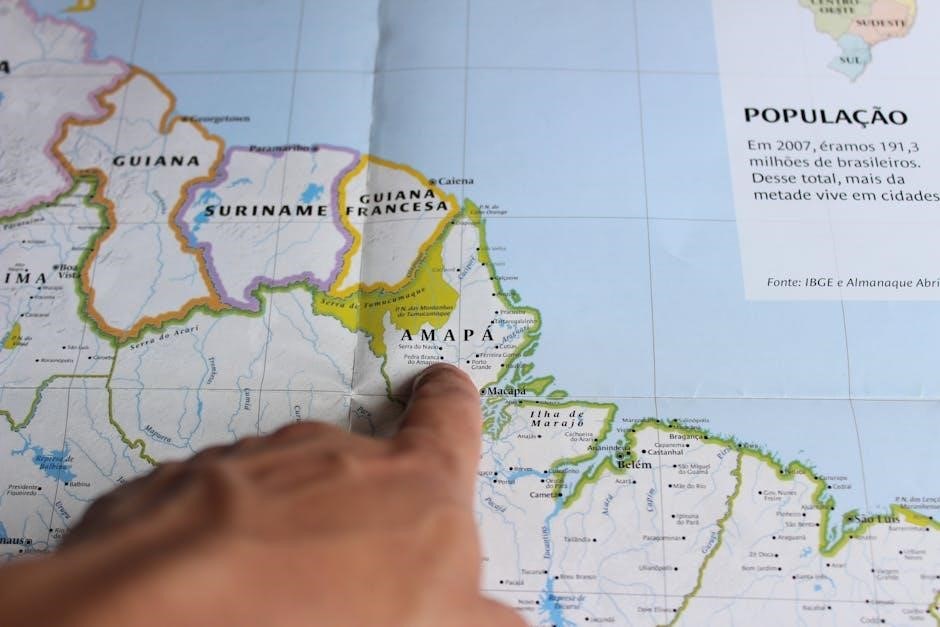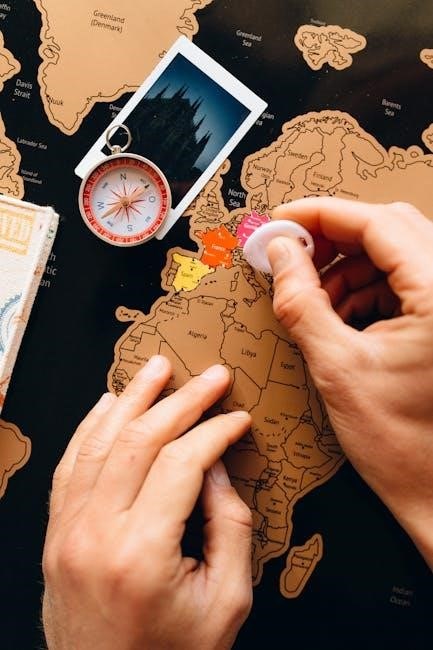Trail guides connect diverse regions, cultures, and ecosystems, offering insights into world geography․ They link landscapes, histories, and communities, fostering exploration and understanding of global environments and heritage․
Definition and Purpose
A trail guide is a detailed resource that maps out pathways, highlighting geographical features, historical sites, and cultural landmarks․ Its primary purpose is to aid explorers in navigating terrains, whether for recreation or educational purposes․ By documenting routes and points of interest, trail guides promote tourism and preserve historical narratives․ They also serve as connectors between regions, fostering a deeper understanding of global diversity․ For instance, guides like the Katy Trail or Kruger Trail illustrate how these resources bridge natural landscapes with human experiences, encouraging both adventure and learning, while also supporting sustainable tourism practices․

Importance in World Geography
Trail guides play a vital role in world geography by documenting pathways that connect diverse landscapes, cultures, and ecosystems․ They highlight key features like mountains, rivers, and forests, showcasing geographical diversity․ Trails such as the Katy Trail and the Kruger Trail illustrate how these routes unite regions, fostering exploration and understanding of global environments․ By mapping historical and natural pathways, trail guides preserve cultural heritage and promote sustainable tourism․ They also serve as educational tools, helping users appreciate the interconnectedness of ecosystems and human activities․ Whether for recreation or research, trail guides are essential for navigating and appreciating the world’s geographical richness and complexity․

Key Regions for Trail Exploration
Trail guides highlight key regions like Asia’s Himalayas, Africa’s savannas, Europe’s historic trails, and the Americas’ diverse landscapes, each offering unique geographical and cultural experiences․

Asia: The Himalayas and Beyond
Asia’s Himalayas offer some of the world’s most iconic trails, with breathtaking mountain vistas and diverse ecosystems․ Beyond the Himalayas, regions like the Gobi Desert and Mekong Delta provide unique trail experiences․ These trails connect cultures, histories, and natural wonders, from ancient trade routes to modern trekking paths․ The Himalayas, home to Everest, draw adventurers globally, while lesser-known trails in countries like Nepal, Tibet, and Bhutan offer untouched landscapes․ Forests, rivers, and wildlife-rich areas further enhance Asia’s trail diversity, making it a paradise for explorers seeking both natural beauty and cultural immersion․ Each trail tells a story of Asia’s rich heritage and geographical splendor․
Africa: Savannas and Wildlife Trails
Africa’s savannas and wildlife trails offer unparalleled opportunities to explore diverse ecosystems and witness incredible biodiversity․ The Kruger Trail, spanning from Crooks Corner to Malelane Gate, is a prime example, showcasing the continent’s rich wildlife and natural beauty․ These trails allow adventurers to immerse themselves in the African wilderness, encountering iconic species like the Big Five․ Guided tours and well-marked paths ensure safe and enriching experiences, while also promoting conservation efforts․ Beyond the savannas, Africa’s trails wind through forests, mountains, and deserts, each with unique flora and fauna․ Whether hiking, biking, or on a safari, Africa’s trails provide a deep connection to the land, its history, and its vibrant cultures, making them a cornerstone of global trail exploration․
Europe: Historic and Scenic Trails
Europe’s trails offer a blend of history, culture, and natural beauty, with iconic landscapes like the Swiss Alps and the Matterhorn providing breathtaking backdrops for hikers and bikers․ The charming town of Zermatt, nestled below the Matterhorn, is a hub for scenic trails that wind through picturesque villages and alpine meadows․ Beyond the mountains, Europe’s historic trails, such as those in Aberdeen, reveal rich cultural heritage, guiding visitors through centuries of history․ These trails often pass by medieval castles, ancient ruins, and quaint villages, connecting the past with the present․ Whether exploring rugged coastlines, lush forests, or historic pathways, Europe’s trails invite adventurers to immerse themselves in the continent’s diverse landscapes and storied legacy․
The Americas: Diverse Landscapes
The Americas boast an extraordinary variety of landscapes, from the rugged Rocky Mountains to the lush Amazon rainforest and the arid deserts of the southwest․ The Katy Trail, a 240-mile rails-to-trails project in the USA, highlights the continent’s ability to transform industrial infrastructure into scenic pathways for hikers and bikers․ In South America, trails like the Inca Trail in Peru offer a glimpse into ancient civilizations, winding through cloud forests and Andean highlands․ These trails not only connect diverse ecosystems but also preserve cultural heritage, allowing explorers to experience the rich history and natural beauty of the Americas․ Such pathways are vital for both recreation and conservation, showcasing the continent’s ecological and historical significance․

Popular Trail Networks
Popular trail networks connect diverse landscapes, fostering exploration and outdoor activities․ They highlight cultural heritage and natural beauty, promoting conservation and recreation across global regions․
The Katy Trail: Rails-to-Trails in the USA
The Katy Trail, a 18․2-mile paved public park, transformed from a historic railroad into a vibrant outdoor space․ Once serving freight trains and the Ringling Bros; Circus, it now offers scenic biking, walking, and outdoor activities․ Celebrating its 30th anniversary, it stands as the nation’s longest rails-to-trails project, connecting communities and showcasing natural beauty․ This trail exemplifies adaptive reuse, blending history with modern recreation, and has become a cornerstone for regional tourism and environmental appreciation in the USA․
The Kruger Trail: Wildlife Exploration in Africa
The Kruger Trail, a renowned wildlife trail in Africa, spans from Crooks Corner in the north to Malelane Gate in the south․ This trail, part of the Kruger National Park, offers unparalleled opportunities to explore diverse wildlife, including the Big Five: lions, elephants, buffalo, leopards, and rhinos․ Over the years, Wilson has traversed its length, showcasing its rich biodiversity and natural beauty․ The trail is a testament to Africa’s conservation efforts, providing a platform for eco-tourism and sustainable wildlife exploration․ It remains a vital pathway for researchers, tourists, and adventurers, highlighting the importance of preserving Africa’s natural heritage․
Aberdeen Trails: History and Heritage
Aberdeen’s trails offer a gateway to exploring the city’s rich history and cultural heritage․ Recently, 10 new trail guides were introduced, along with a smartphone feature, designed to help locals and visitors discover historic sites․ These trails weave through landmarks, connecting the past with the present, and highlight Aberdeen’s significance as a city steeped in history․ From medieval architecture to industrial heritage, the trails provide a unique perspective on the city’s evolution․ The launch of these guides underscores Aberdeen’s commitment to preserving its heritage while embracing modern technology to enhance the exploration experience․ This initiative not only promotes tourism but also fosters a deeper appreciation for the city’s historical roots․

Geographical Features Along Trails
Trails like the Katy Trail, once a railroad, now offer 18․2 miles of paved paths, showcasing how repurposed infrastructure connects communities and highlights regional geography․
Mountain Ranges: The Matterhorn and Others
The Matterhorn, an iconic peak in the Alps, stands at 4,478 meters, offering challenging trails with breathtaking views․ Similarly, the Himalayas boast Everest, the world’s highest summit, while the Rocky Mountains in North America feature rugged landscapes․ Mountain ranges like the Andes in South America and the Atlas Mountains in Africa provide diverse hiking experiences․ These regions attract adventurers seeking thrilling climbs and scenic vistas․ Trails often wind through alpine meadows, glaciers, and snow-capped peaks, making them popular for both seasoned hikers and nature enthusiasts․ The unique geological features of these ranges create unforgettable opportunities for exploration and connect cultures across continents․
River Systems: Impact on Trail Development
River systems have profoundly shaped trail development worldwide, serving as natural pathways for exploration and settlement․ Trails often follow riverbanks, providing scenic routes and access to water sources․ The Amazon River, for instance, has trails that wind through lush rainforests, while the Colorado River offers routes through dramatic canyons․ Rivers also influence trail placement by creating valleys that act as natural corridors through mountainous regions․ Many trails, like those along the Nile or Mekong, have historical significance as trade and migration routes․ Today, rivers continue to attract hikers and bikers, offering diverse ecosystems and opportunities to connect with nature and cultural heritage․
Forest Ecosystems: Biking and Hiking
Forest ecosystems provide some of the most breathtaking trails for biking and hiking, offering immersive experiences in nature․ Dense woodlands, such as those in the Pacific Northwest or the Black Forest, feature well-marked paths that cater to both beginners and experienced adventurers․ Trails like the Appalachian Trail in North America or the Eifelsteig in Germany showcase diverse flora and fauna, while also preserving ecological balance․ Biking through forests allows riders to explore vast terrains, from smooth, shaded paths to challenging singletracks․ Hiking trails often highlight unique features like waterfalls, clearings, and wildlife habitats․ These trails not only promote physical activity but also foster a deeper connection with nature and its conservation․

Trail Safety and Etiquette
Trail safety and etiquette are essential for responsible exploration․ Assessing risks, using proper gear, and following local guidelines ensure a secure journey․ Respecting the environment and cultural norms fosters harmony between visitors and local communities, preserving trails for future generations․
Essential Preparations for Hikers
Proper preparation is vital for a safe and enjoyable hiking experience․ Hikers should research the trail’s difficulty, terrain, and weather conditions beforehand․ Ensuring physical fitness levels match the trail’s demands is crucial․ Carrying a map, compass, and GPS device, along with extra batteries, is essential for navigation․ Wearing appropriate footwear, layered clothing, and protective gear ensures comfort and safety․ Packing sufficient water, snacks, and a first-aid kit is a must․ Awareness of potential hazards, such as wildlife or unstable terrain, helps prevent accidents․ Informing someone about the itinerary and expected return time is a key safety measure․ Being prepared fosters confidence and readiness for any situation․
Environmental and Cultural Etiquette
Respecting the environment and local cultures is paramount when exploring trails․ Hikers should adhere to the “Leave No Trace” principle, disposing of waste properly and avoiding damage to flora and fauna․ Staying on designated paths helps preserve fragile ecosystems․ Cultural sensitivity involves understanding and respecting local traditions, sacred sites, and community norms․ Learning a few phrases in the local language and asking permission before photographing people or sites fosters goodwill․ Supporting local economies by purchasing supplies and services from nearby communities promotes sustainable tourism․ By embracing these practices, hikers contribute to environmental conservation and cultural preservation, ensuring trails remain accessible and meaningful for future generations․

Cultural and Historical Significance
Trails have historically served as pathways for civilizations, trade routes, and migrations, shaping cultural identities and preserving history․ They connect communities, fostering cultural exchange and storytelling across generations․
Trails as Historical Pathways
Trails have long served as vital pathways for the movement of people, goods, and ideas throughout history․ Many ancient trails, such as the Silk Road and the Oregon Trail, were instrumental in shaping global trade, migration, and cultural exchange․ These routes connected distant regions, facilitating the spread of religions, technologies, and languages․ Historical trails often reflect the political and economic priorities of past societies, with pathways like the Inca Trail and the Roman Roads showcasing engineering prowess and imperial ambitions․ Today, these trails remain as living archives, offering insights into the past and preserving the legacies of civilizations that once flourished along them․
Modern-Day Cultural Experiences
Modern trails offer more than just physical adventures; they serve as gateways to vibrant cultural experiences․ Many contemporary trails are designed to highlight local traditions, festivals, and community life․ For instance, the Camino de Santiago in Europe attracts pilgrims and travelers seeking spiritual and cultural enrichment․ Similarly, the Appalachian Trail in North America fosters connections between hikers and rural communities․ In Asia, trekking routes like the Annapurna Circuit provide opportunities to experience village life and indigenous customs․ These trails have become platforms for cultural exchange, allowing visitors to immerse themselves in local cuisines, music, and storytelling․ They bridge the gap between global exploration and community-driven heritage preservation․

Environmental Impact of Trails
Trails can harm ecosystems through erosion and habitat disruption but also promote conservation by raising awareness and supporting protected areas, creating a dual environmental influence․
Conservation Efforts Through Trails
Trails play a vital role in promoting conservation by providing access to remote areas for researchers and conservationists․ They enable the monitoring of wildlife and ecosystems, helping to protect endangered species․ Trails also serve as corridors for wildlife, connecting fragmented habitats and fostering biodiversity․ Additionally, trails raise environmental awareness among hikers and bikers, encouraging stewardship of natural landscapes․ Many trails are integrated into protected areas, supporting reforestation and anti-poaching initiatives․ By linking communities to nature, trails inspire local involvement in conservation projects, ensuring sustainable management of ecosystems for future generations while balancing human activity with environmental preservation․
Sustainable Tourism Practices
Sustainable tourism practices are essential for preserving the integrity of trails and their surrounding environments․ By promoting eco-friendly accommodations and waste reduction, trail systems minimize their ecological footprint․ Tourists are encouraged to adopt “leave no trace” principles, ensuring trails remain pristine for future visitors․ Local communities benefit economically through responsible tourism, fostering a balance between livelihoods and environmental protection․ Educational programs also play a role, informing visitors about the importance of conservation and cultural heritage․ Regulated visitor numbers and trail maintenance further ensure sustainability․ These practices not only protect natural and cultural resources but also enhance the overall trail experience, creating a harmonious relationship between tourism and the environment․
Trails serve as vital connectors, linking landscapes, cultures, and histories worldwide․ They offer timeless opportunities for exploration, fostering global understanding and appreciation of diverse environments and traditions․
The Role of Trails in Global Connectivity
Trails have historically served as vital connectors, linking regions, cultures, and ecosystems across the globe․ From ancient trade routes like the Silk Road to modern hiking paths, trails foster exchange and understanding․ They bridge geographical divides, enabling the sharing of ideas, goods, and traditions․ Today, trails continue to unite people, promoting cultural exchange and environmental awareness․ By traversing trails, individuals gain insights into diverse landscapes and communities, strengthening global connectivity․ Trails also support eco-tourism, fostering sustainable development and cross-border collaboration․ Ultimately, they embody the spirit of exploration and unity, inspiring future generations to explore and appreciate the world’s interconnectedness․

Encouraging Future Exploration
Trails serve as gateways to unexplored landscapes, inspiring future generations to venture into the unknown․ By preserving and expanding trail networks, we ensure access to remote areas, fostering curiosity and adventure․ Education and outreach programs can highlight the importance of trails, encouraging youth to engage with nature and culture․ Advances in technology, such as digital trail maps, make exploration more accessible․ Community-driven initiatives and international collaborations can promote trail development, creating pathways for global discovery․ As trails evolve, they will continue to spark a sense of wonder, inspiring people to explore, learn, and connect with the world’s diverse environments and cultures․
